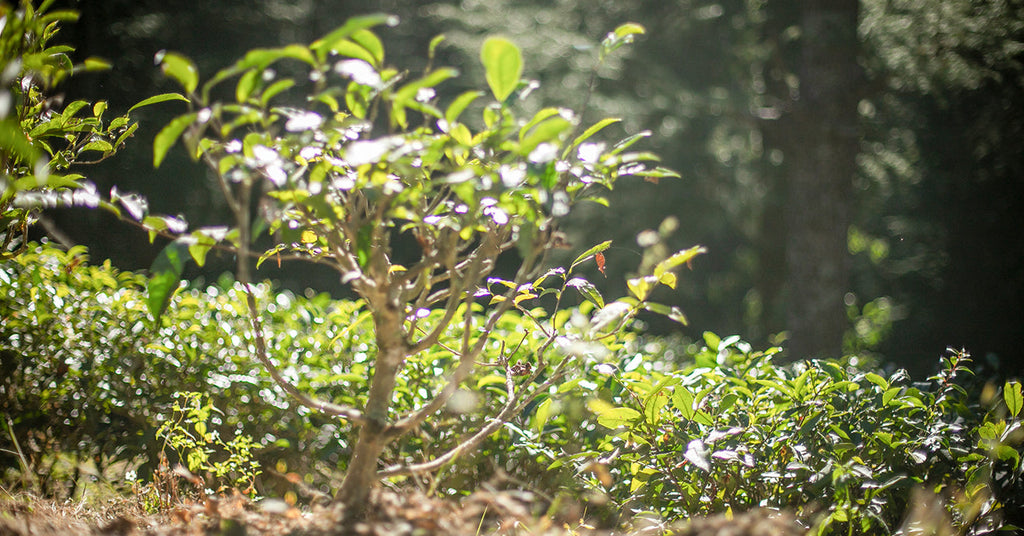Tea’s Carbon Capture Potential

The topic of regenerative agriculture has a lot of people talking, and I’m now one of them. This emerging set of farming practices offers a compelling link between climate change mitigation and food system change. The basic premise is that plants consume carbon dioxide, so growing food crops in smart ways can chip away at the carbon load.
As a student of tea, I’ve been wondering, just how much carbon can a tea garden sequester? The average acre of tea has 6,000 tea trees growing in it, so that’s a lot of potential. To get to the root of it all (always go for the pun, right?), I researched the topic. To keep my scientist friends happy, I’ve tried to differentiate between what peer-reviewed articles have established as legit science and where I’m making assumptions. I’m hopeful this will jumpstart some conversation, so if you have thoughts or suggestions, please drop them in the comments!
How Does Tea Sequester Carbon?
It all begins with the befuddling magic of photosynthesis. All land-based plants create their own food by drinking carbon dioxide out of the air and combining it with water and sunlight to produce sugar and oxygen. The full process looks like this: 6CO2 + 6H2O → C6H12O6 + 6O2. Translated, six molecules of carbon dioxide in the air become a single molecule of sugar that the plant uses for food. And it’s the first “C” to the right of the arrow in the sugar—the C6H12O6—that represents the carbon we’re talking about being sequestered.
That carbon winds up primarily in two places:
- In the biomass of the plant (i.e., the woody material that forms a tree’s trunk, branches, and leaves).
- In the ground (thanks microbes!). And since tea is a perennial —meaning a farmer plants a seed or sapling into the ground then harvests the same bush for years —a single tea bush sequesters carbon for its entire life. Often, tea bushes live 100+ years!
Since the soils of tea fields aren’t disturbed, the carbon underground remains sequestered. This is a big part of the regenerative agricultural movement that came as a surprise to me: the iconic pictures of farmers tilling fields is actually really damaging to the soil health, and any carbon stored in the top soil becomes released. Fortunately, tea gardens are not tilled. Phew!
How Much Carbon Does Tea Sequester?

Carbon assimilated into the biomass.
For this, we turn to the experts. One particularly helpful article available on the National Institute of Health from 2020 titled Assimilating Atmospheric Carbon Dioxide In Tea Gardens of Northeast India by Pramanik and Phukan shared a couple of important concepts:
- The cultivar matters: High-yielding cultivars store more carbon than quality-oriented cultivars.
- Age of the bush matters: Once a tea bush reaches full maturity (25-30 years), it's sequestering more than when it is very young.
- Shade trees matter: Tea plants sequester just over half (55%) of the carbon, while the shade trees sequester the rest (45%).
Taking into account these three factors, the study found that an average hectare of an Indian tea garden (equal to 2.5 acres) sequesters roughly 5,100 kg-CO2/yr in the tea bushes, and roughly 4,000 kg-CO2/yr in shade trees. Those combine for a total of 9,100 kg-CO2/yr/Ha. That’s data point number one!

Carbon sequestered into the soil.
However, that 9,100 kg-CO2 is only the carbon that’s stored in the biomass of the tea bushes and shade trees. What about the carbon stored in the soil? For that, I had to do a little extrapolation. The Intergovernmental Panel on Climate Change (IPCC) states that across all forest types, 31% of carbon is stored in biomass and 69% in the soils. For tropical forests, they report that ratio is close to 50/50. Since tea grows in subtropical environments, it is likely higher than 31%, but since a tea garden isn’t really a true forest, it’s probably less than the full 50%. To be conservative, I went with a nice round 33% in the biomass, 66% in the soil (or ⅓ in the biomass, ⅔ in the soil). This is the most influential assumption I made in my calculation.
This means that if 9,100 kg-CO2 is in the biomass, twice that amount (or 18,200 kg-CO2) is in the soil. Combining the biomass and the soil numbers, we get 27,300 kg-CO2 per hectare per year. Doing the conversions from hectares to acres and kilograms to pounds, we get to our punchline:
Growing tea sequesters ~31,000 lbs of CO2 per acre per year
(31,217 to be more precise)
What’s Tea’s Carbon Offset Equivalent?

Great, we have a number! 31,000! But what does that mean? To make sense of this, the EPA has a handy carbon equivalency calculator that gives common reference points. I looked at the tea gardens for all our smallholder farmer groups, and I found that each village is growing ~150 acres of tea on average (147.9 to be exact). Combining it all:
The average Indian village of tea farmers is offsetting enough carbon to replace:
360 passenger cars
300 American homes using electricity
3,839 barrels of crude oil
2,325 MW-hr of electricity
Let's say this again...the emissions from 300 American homes can be offset by a single village of Indian tea farmers. That is something exciting indeed to think about!
Read More About Tea’s Impact:
- What is Regenerative Agriculture?
- How Your Tea Purchase Makes an Impact
- A Guide to Zero-Waste Tea Packaging
Blog Author:

Raj Vable, Founder
Raj has been confounded by the leaf since his first transcendental encounter with white tea in 2010. Three years later, he started Young Mountain Tea to bridge his budding tea obsession with his interest in traveling in the mountains and previous experience creating job opportunities in rural India. He revels in working across cultures and can be regularly found trying to get the rest of the team on board with another outlandish tea project. His favorite teas remain white, and he’s always searching for the next cup of magic.


Comments on this post (5)
Thanks for feeding my inner geek and doing the math!
I grow the Sochi variety in Oregon (zone 8b) and my 15 year old plant was about 5’ wide by 5’ tall! I moved last fall, so am beginning again with several small plants and several seedlings – and will keep these trimmed lower for harvest.
I have several raised beds already, and aim for minimal disturbance. I also tend a raised 4×4’ tea garden, a part of our Edible Landscape of Yamhill Co project. The central plant is a Tea camellia 4-5 years old, plus several perennial and annual herbs for tisanes. We have 28 beds on the East side of McMinnville, and recently received a grant to expand the project. (More tea?)
— Nadya
LOL, John! But together, we can support that single tea village and offset those 300 homes’ electricity. Thanks for doing your part!
— Young Mountain Tea
Interesting! Very helpful math
— Anceita
Thank you for doing the math for us in this fascinating blog!
— Marlene
If one village of tea growers offsets 300 American homes, how much tea is that? Note: whatever the weight of that amount of tea I seriously doubt I can drink that much tea 🍵.
— John C Taylor